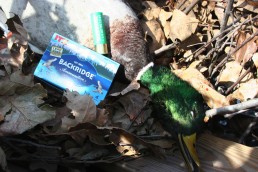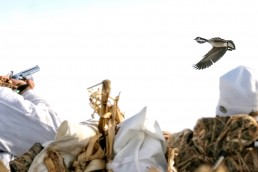New Non-toxic Backridge ITX Shot Beyond Impressive
SHARE THIS POST
Shooting big guns and meeting interesting people
Test hunts with new products take gun writers to a lot of interesting places where we shoot with interesting folks. In this case, some old U.S. Army combat vets and active Special Operations soldiers helped test a brand-new, non-toxic ITX shot.
I’ve been a lot of places to test firearms and ammo. However, I was taken aback when my contact driver from the airport, Sgt. Robert Craigo—a retired chopper crew chief—rolled up on a small, backcountry, wood-frame building that housed the new Backridge Ammunition company.
While awaiting company CEO Major Adam Ziegler, Sgt. Craigo gave me the grand tour of the manufacturing facility. It resembled many others I’ve seen in the start-up phase. Backridge was Ziegler’s brainchild. With 18 years of service in the 101st Airborne and a pile of operation time in the Mideast, Ziegler’s parachute didn’t open fully during a training jump, sending him hard into the ground. Ziegler had some time on his hands. During rehab, he got the idea of building a new, non-toxic type of duck and goose load.
Innovating on an empty wallet
Working with a tight budget, the old warhorse caught the attention of the folks at Continuous Metal Technology. This powder metals company was developing ITX shot. It’s a combination of tungsten, iron and a binding agent that makes it heavy, yet easy on gun barrels and chokes.
The Major observed a couple of things about current shells that used tungsten-based pellets. First, each shot-shell cost a lot. Second, most of these loads required almost armor-plated delivery systems to not cut shotgun bores to pieces. Handling these issues was a good first step towards more affordable, “designer” type tungsten shot-shell ammo.
The staging area
Our base was a white farmhouse in the middle of No Place, USA, about two hours out of Reelfoot Lake, Tenn. The camp consisted of Special Forces and other classified operations soldiers who seldom have time to live like normal folks. These guys are on the hotline 24/7. When they want to hunt or fish, arranging an outdoor event is almost impossible. An outfit called Special Operation Excursions ran the camp. No name on the door, and no general phone number to call. With this situation, it just has to be that way. Last year, more than 350 soldiers and family came through the doors of this amazing outfit.
Special ops chopper pilots, gunners, snipers, and small-team insertion members were the meat of the Major’s new ammo test project. Are there better men to check out a new product and then give an honest opinion of its performance than these specialized, war-proven fighters? I don’t think so.
For the next three days, we stayed up late talking ballistics and guns. Then, we loaded up early for Reelfoot and superb waterfowl gunning.
Insights from the best of the best
Although I was an outsider, I never felt snubbed or pushed aside. Some of the snipers and others had read my books on both rifles and shotguns which, to be frank, let me walk just a bit taller among them. These are my heroes to the core, and we sleep better because of their sacrifice.
Check out Brezny’s picks for some of the best new guns out there.
Are you enjoying this post?
You can be among the first to get the latest info on where to go, what to use and how to use it!
Now, it was time to hit the beach. We packed into some super jon boats powered by 115-hp outboards that took us to massive stilt blinds. These housed the boats and a kitchen for all meals on the water. Each gunner had a sky-top shooting hatch where he looked out over maybe 800 decoys on the edge of cypress swamp timber.
ITX shot in a #4 pellet, loaded to a rather soft-shooting velocity of 1200 f.p.s., packs a wallop. The shot itself has a “cutter” surface edge. This Saturn-like ring on each pellet radiates the kinetic energy of the individual pellet, causing additional tissue damage. The first thing I noticed, even on birds downed at longer range, was the amount of blood that came though the feathers. The subjects were wet with blood like waterfowlers see only on bluebills hit hard at close range. Our birds were, for the most part, drake mallards and gadwalls with a few other assorted brands.
Hard facts
Running a crush test, the ITX shot has a very soft hardness rating. A tap with a hammer on steel plate flattens out the pellet with ease. This means ITX shot is easy on barrels or chokes. Major Ziegler was good enough to forward detailed photos of ducks after the hunt that illustrated just how crushing the ITX loads were. I took both tightly decoying birds as well as some 55-plus-yard passing birds for insight on where the #4 ITX pellets slowed down. The short form is that they didn’t slow down much at all. Longest kill recorded, by way of my Nikon LaserForce system, was 56 yards, and the closer shots averaged 33 yards.
The extended mass delivered downrange by each ITX pellet not only means they can be sent at a low velocity, but they also produce outstanding patterns. It was obvious that the Backridge loads sent payloads in short shot strings and pulverized birds to 40 yards. They also produced solid, penetrating kills on longer-range targets. Considering the damage on ducks and the lack of cripples, I would assign this ammunition at least 4.5 out of 5 stars. This shot type is so good that I might offer it in my subsonic Metro Gun System for my customers. Price is the big deal, here. After checking a number of gun shops and big box stores, Backridge ammo costs about half that of other tungsten-based ammunition.
How can you get your hands on this cutting new shot?
Outside of Backridge’s sale area in Tennessee, ITX is tough to find. However, Backridge will ship anywhere via their e-mail address (adam@backridgeammunition.com)
I saw the new ammo for sale in some major southern gun shops, priced at about $22 per 10 pack in the 3-inch magnum loads of ITX #4 or #2s.
Backridge is staying with about four different primary waterfowl loads for now, but is considering marketing special loads for 20 gauge, 28 gauge, and 10 gauge—shotguns left out of many brands of high-performance non-toxic ammo.
Note that the maximum effective range of this or any shot is above 600 f.p.s. Less velocity can result in cripples. This data is based of live fire testing to 20 yards and at the muzzle when measuring the exact velocity produced by the ITX shot. Based on my research, and that of SHOT DATA System out of New Brighton, Minn., this load, at its tested velocity, can kill cleanly to about 55 yards.
Author notes
L.P. Brezny has worked in research and development across the shooting industry for 37 years. He has developed and marketed systems for 12 gauges, designed ammunition for Winchester and Federal Cartridge, designed separator quiet slugs, shotshells and one-choke do-it-all systems. Brezny was the first ballistics writer to measure shotgun pellets in flight to ranges as great as 100 yards. He has published three books on shooting (Gun Digest Books), and is completing a fourth on long-range rifle applications. He has published hundreds of articles on sending rounds downrange.
MWO
SHARE THIS POST
You may also like...
Did you enjoy this post?
You can be among the first to get the latest info on where to go, what to use and how to use it!
L.P. Brezny
Writing on outdoor subjects for over 40 years, L.P. Brezny has written four books on shotgun and rifle (ballistics and performance). He’s an expert at smoothbore, and high-power, ultra-long-range shooting. He’s a specialist, producing reviews covering general products used in the outdoors industry.

